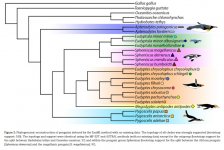Fred Ruhe
Well-known member

Hailin Pan, Theresa L. Cole, Xupeng Bi, Miaoquan Fang, Chengran Zhou, Zhengtao Yang, Daniel T. Ksepka, TomHart, Juan L. Bouzat, Lisa S. Argilla, Mads F. Bertelsen, P. Dee Boersma, Charles-André Bost, Yves Cherel, Peter Dann, Steven R. Fiddaman, Pauline Howard, Kim Labuschagne, Thomas Mattern, Gary Miller, Patricia Parker, Richard A. Phillips, Petra Quillfeldt, Peter G. Ryan, Helen Taylor, David R. Thompson, Melanie J. Young, Martin R. Ellegaard, M. Thomas P. Gilbert, Mikkel-Holger S. Sinding, George Pacheco, Lara D. Shepherd, Alan J. D. Tennyson, Stefanie Grosser, Emily Kay, Lisa J. Nupen, Ursula Ellenberg, David M. Houston, Andrew Hart Reeve, Kathryn Johnson, Juan F. Masello, Thomas Stracke, BruceMcKinlay, Pablo Garcíıa Borboroglu, De-Xing Zhang and Guojie Zhang, 2019
High-coverage genomes to elucidate the evolution of penguins
GigaScience, 8, 2019, 1–17
Abstract and free pdf: https://www.researchgate.net/public...ion_of_penguins.pdf?origin=publication_detail
Background: Penguins (Sphenisciformes) are a remarkable order of flightless wing-propelled diving seabirds distributed widely across the southern hemisphere. They share a volant common ancestor with Procellariiformes close to the Cretaceous-Paleogene boundary (66 million years ago) and subsequently lost the ability to fly but enhanced their diving capabilities. With ∼20 species among 6 genera, penguins range from the tropical Gal ´apagos Islands to the oceanic temperate forests of New Zealand, the rocky coastlines of the sub-Antarctic islands, and the sea ice around Antarctica. To inhabit such diverse and extreme environments, penguins evolved many physiological and morphological adaptations. However, they are also highly sensitive to climate change. Therefore, penguins provide an exciting target system for understanding the evolutionary processes of speciation, adaptation, and demography. Genomic data are an emerging resource for addressing questions about such processes. Results: Here we present a novel dataset of 19 high-coverage genomes that, together with 2 previously published genomes, encompass all extant penguin species. We also present a well-supported phylogeny to clarify the relationships among penguins. In contrast to recent studies, our results demonstrate that the genus Aptenodytes is basal and sister to all other extant penguin genera, providing intriguing new insights into the adaptation of penguins to Antarctica. As such, our dataset provides a novel resource for understanding the evolutionary history of penguins as a clade, as well as the fine-scale relationships of individual penguin lineages. Against this background, we introduce a major consortium of international scientists dedicated to studying these genomes. Moreover, we highlight emerging issues regarding ensuring legal and respectful indigenous consultation, particularly for genomic data originating from New Zealand Taonga species. Conclusions: We believe that our dataset and project will be important for understanding evolution, increasing cultural heritage and guiding the conservation of this iconic Southern hemisphere species assemblage.
Enjoy,
Fred
High-coverage genomes to elucidate the evolution of penguins
GigaScience, 8, 2019, 1–17
Abstract and free pdf: https://www.researchgate.net/public...ion_of_penguins.pdf?origin=publication_detail
Background: Penguins (Sphenisciformes) are a remarkable order of flightless wing-propelled diving seabirds distributed widely across the southern hemisphere. They share a volant common ancestor with Procellariiformes close to the Cretaceous-Paleogene boundary (66 million years ago) and subsequently lost the ability to fly but enhanced their diving capabilities. With ∼20 species among 6 genera, penguins range from the tropical Gal ´apagos Islands to the oceanic temperate forests of New Zealand, the rocky coastlines of the sub-Antarctic islands, and the sea ice around Antarctica. To inhabit such diverse and extreme environments, penguins evolved many physiological and morphological adaptations. However, they are also highly sensitive to climate change. Therefore, penguins provide an exciting target system for understanding the evolutionary processes of speciation, adaptation, and demography. Genomic data are an emerging resource for addressing questions about such processes. Results: Here we present a novel dataset of 19 high-coverage genomes that, together with 2 previously published genomes, encompass all extant penguin species. We also present a well-supported phylogeny to clarify the relationships among penguins. In contrast to recent studies, our results demonstrate that the genus Aptenodytes is basal and sister to all other extant penguin genera, providing intriguing new insights into the adaptation of penguins to Antarctica. As such, our dataset provides a novel resource for understanding the evolutionary history of penguins as a clade, as well as the fine-scale relationships of individual penguin lineages. Against this background, we introduce a major consortium of international scientists dedicated to studying these genomes. Moreover, we highlight emerging issues regarding ensuring legal and respectful indigenous consultation, particularly for genomic data originating from New Zealand Taonga species. Conclusions: We believe that our dataset and project will be important for understanding evolution, increasing cultural heritage and guiding the conservation of this iconic Southern hemisphere species assemblage.
Enjoy,
Fred




